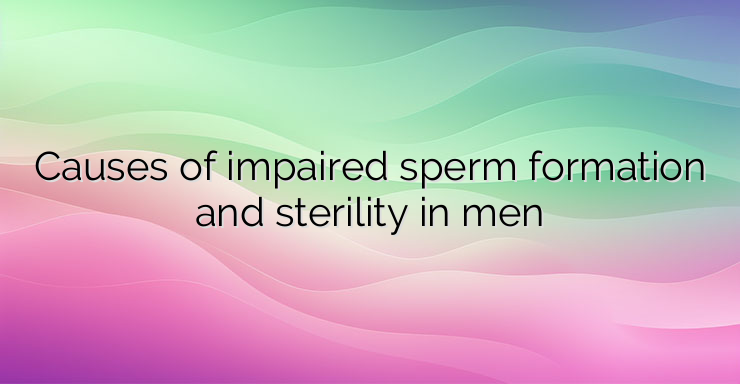A number of conditions can cause oligozoospermia – a low concentration of sperm in the seminal fluid. The hypothalamus produces and secretes gonadotropin-releasing hormone – GnRH, which reaches the anterior lobe of the pituitary gland and stimulates gonadotrope cells to release luteinizing hormone – LH and follicle-stimulating hormone – FSH into the systemic circulation. LH stimulates the Leydig cells of the testes to synthesize and secrete testosterone, while FSH stimulates the Sertoli cells in the seminiferous tubules to promote spermatogenesis. Testosterone, some of which is aromatized into estradiol, and inhibin B, which is secreted by the Sertoli cells, then provide negative feedback to the hypothalamus and pituitary to decrease LH and FSH secretion, respectively. Deficiency of GnRH secretion is most often congenital. Usually, this condition is diagnosed by the lack of puberty at puberty, although there are partial forms of the disease that allow a limited degree of pubertal development or, in rare cases, even full pubertal development before the onset of hypogonadotropic hypogonadism. Genetic causes The diagnosis of severe oligozoospermia is often due to genetic causes of infertility. Klinefelter syndrome is the most common chromosomal abnormality in males. Azoospermia is observed in most patients, while oligozoospermia is characteristic of genetic mosaicism. In patients with a preserved karyotype, deletions of the long arm of the Y chromosome are a genetic factor for male infertility. Such Y chromosome microdeletions have been identified in 5% to 10% of patients with azoospermia and in 2% to 5% of patients with the severe form of the condition. Mutations in the cystic fibrosis transmembrane conductance regulator gene – CFTR often lead to infertility. Most often, these mutations cause congenital bilateral absence of the vas deferens and azoospermia. In affected patients, a small volume of seminal fluid is observed, which is released during ejaculation and is the result of the absence of seminal vesicles. Anatomical disorders Varicocele is the result of pathological expansion of the venous plexuses in the spermatic cord. Varicocele occurs in 35% to 40% of men with reproductive disorders and can lead to changes in spermatogenesis, shedding of seminiferous tubule germ cells, testicular atrophy, and decreased testosterone production. This condition results in testicular hyperthermia, increased testicular oxidative stress, and reflux of renal and adrenal metabolites that have a toxic effect on spermatogenesis. Blockage of the vas deferens occurs in about 1% to 5% of infertility patients. They have hecateric oligozoospermia or azoospermia and reduced ejaculate volume. Ductal obstruction may be partial or complete, unilateral or bilateral, and seminal fluid analysis may also show a reduced fructose concentration and low pH.as a result of the loss of the alkalizing secretions of the seminal vesicles in the ejaculate. Retrograde ejaculation can also occur as a result of spinal cord injury, neurological disorders, diabetes mellitus, after surgery or the use of drugs that cause the bladder neck to relax, such as alpha-antagonists. Obesity Obesity also leads to an increased risk of oligospermia. It is associated with elevated leptin levels and insulin resistance. This is associated with decreased GnRH secretion, thereby decreasing gonadotropin secretion as well. In addition, obesity increases the expression of aromatase, which converts testosterone to estradiol. In this way, androgen deficiency is enhanced and suppression of the hypothalamic-pituitary-gonadal axis is supported. Taking medications Taking multiple medications affects the functioning of the hypothalamic-pituitary-testicular axis and can lead to infertility due to oligozoospermia. The effects of long-term opioid therapy on the endocrine glands include suppression of the hypothalamic-pituitary-gonadal axis by interrupting hypothalamic pulsatile secretion of gonadotropin-releasing hormone, leading to hypogonadism, sexual dysfunction, and infertility. These effects are seen in up to 63% of patients taking opiates. Higher doses and longer durations of opioid therapy are associated with an increased prevalence of opioid-induced hypogonadism, although the effect tends to be reversible after discontinuation. Misuse of androgenic steroids is common. Many synthetic androgens dramatically increase muscle mass and strength, but their use results in significant increases in serum androgen levels. This results in negative feedback suppression of the hypothalamic-pituitary-gonadal axis. Excess testosterone can aromatize to estradiol, leading to side effects such as gynecomastia and suppression of pituitary gonadotropin secretion. Testicular atrophy and oligozoospermia are common. Although function of the hypothalamic-pituitary-gonadal axis can be restored after withdrawal of anabolic agents, full recovery of spermatogenesis may require months due to the long half-life of some of these androgens. Glucocorticoids are widely used in the treatment of various autoimmune and inflammatory diseases. They can also be the cause of hypogonadotropic hypogonadism, since they act on the hypothalamus and lead to a decrease in the synthesis and release of gonadotropin-releasing hormone. Suppression of the gonadal axis becomes more pronounced with long-term glucocorticoid therapy. In addition, glucocorticoids can directly inhibit testosterone biosynthesis by Leydig cells in the testes. References: https://www.ncbi.nlm.nih.gov/pmc/articles/PMC7566408/#:~:text=Oligozoospermia%20refers%20specifically%20to%20the,million%20sperm%2FmL%20of%20ejaculate.


Leave a Reply